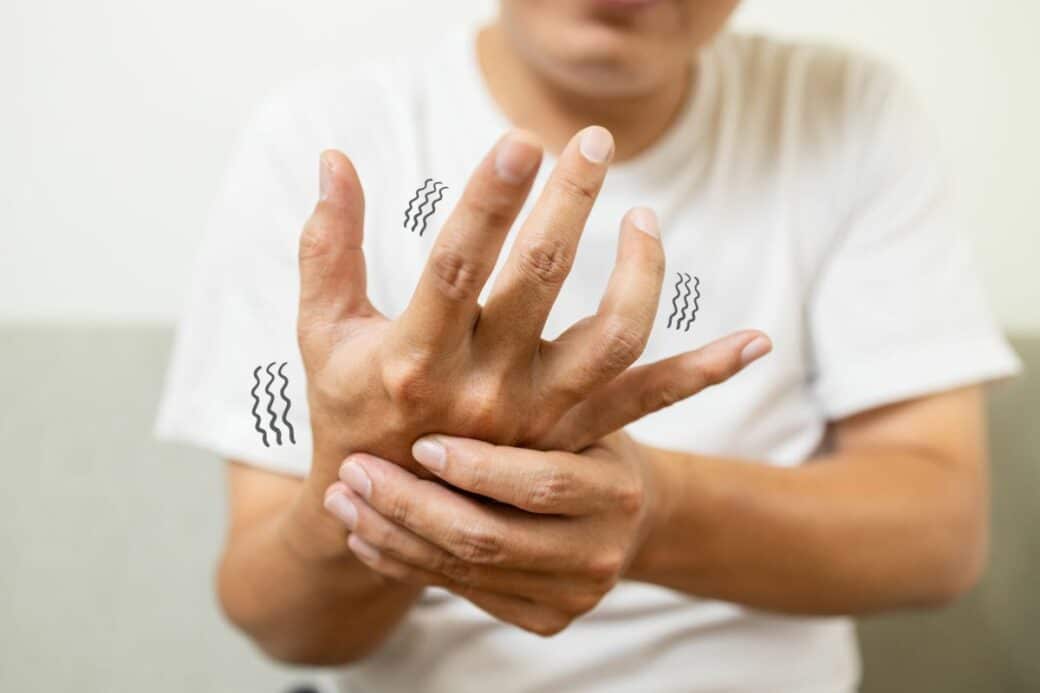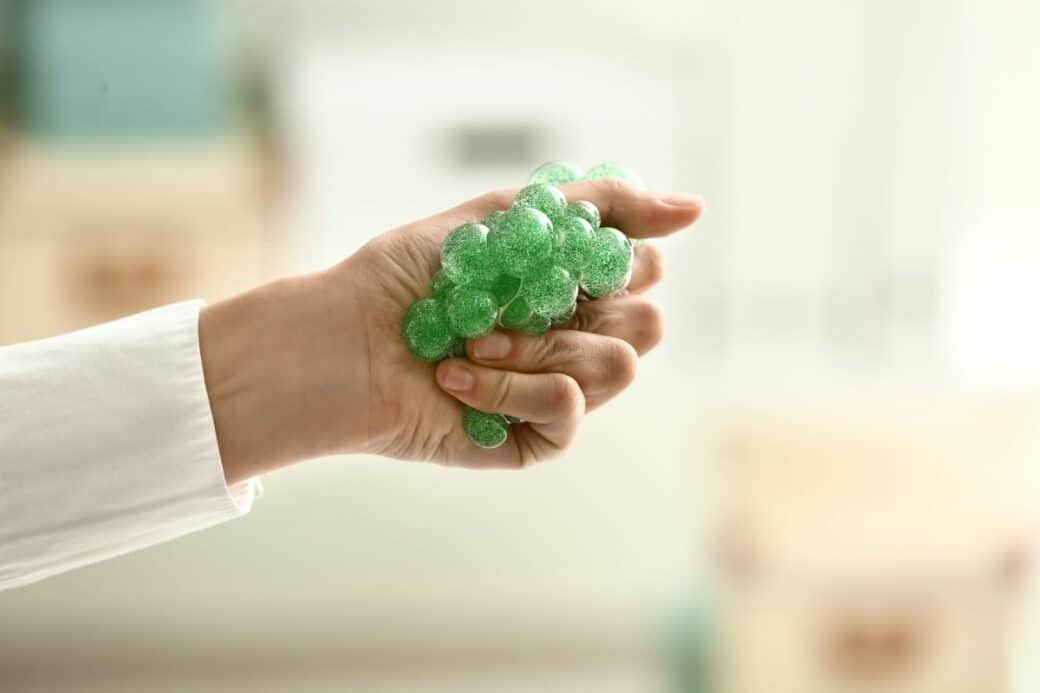Whether you’re dealing with the occasional hand tremor or a more persistent shake, finding an effective way to control your body’s involuntary movements can be a challenge. Enter stress balls. These squishy, handheld objects have been touted as a way to relieve stress and anxiety, but can they really help with tremors? In this article, we’ll explore the science behind stress balls and their potential benefits for those dealing with tremors. So grab a stress ball, get comfortable, and let’s find out if this simple yet intriguing solution could be the answer you’ve been searching for.

Do Stress Balls Help Tremors: Understanding Tremors
Definition of Tremors
Tremors are involuntary, rhythmic movements of one or more parts of the body, most commonly the hands, arms, head, or voice. These movements can range from slight shaking to more pronounced trembling, making it difficult for individuals to perform everyday tasks with ease.
Causes of Tremors
Tremors can have various causes, including neurological conditions such as Parkinson’s disease, multiple sclerosis, essential tremor, or dystonia. They can also be triggered by certain medications, drug or alcohol withdrawal, anxiety, stress, or conditions affecting the thyroid or liver. Identifying the underlying cause is important in determining the most effective approach for managing tremors.
Different Types of Tremors
There are several types of tremors, each characterized by specific patterns and triggers. The most common types include essential tremor, which typically occurs during voluntary movement and worsens with age, and Parkinsonian tremor, which is associated with Parkinson’s disease and often affects one hand or foot while at rest. Other types include dystonic tremor, cerebellar tremor, and orthostatic tremor, each with its own distinct characteristics.
Symptoms and Diagnosis of Tremors
The symptoms of tremors can vary, depending on the underlying cause and type of tremor. Common signs include rhythmic shaking, difficulty with fine motor tasks, such as writing or holding objects, and an increase in tremor severity during times of stress or anxiety. Diagnosis typically involves a thorough medical history, physical examination, and in some cases, neuroimaging or laboratory tests to rule out other potential causes.
The Impact of Tremors
Effects on Daily Life
Tremors can significantly impact daily life, making it challenging to perform basic tasks such as eating, dressing, or writing. These physical limitations can diminish an individual’s independence and self-confidence, leading to frustration and reduced quality of life. Simple activities such as pouring a cup of coffee or buttoning a shirt can become arduous, highlighting the importance of finding effective ways to manage tremors.
Psychological Impact of Living with Tremors
Living with tremors can take a toll on an individual’s emotional well-being. Constantly dealing with visible shaking can lead to embarrassment, self-consciousness, and social anxiety. Feelings of isolation, depression, and frustration are not uncommon among individuals with tremors. Addressing the psychological impact is crucial to ensure a holistic approach to tremor management.
Social Challenges Faced by Individuals with Tremors
Individuals with tremors may face social challenges, as the visible shaking can sometimes be misunderstood or misinterpreted by others. Some individuals may feel self-conscious and avoid social situations, leading to a sense of disconnection from friends, family, and the broader community. Educating others about tremors and promoting acceptance and understanding can help alleviate these social challenges.

Traditional Treatments for Tremors
Medical Treatments
Medical treatments for tremors may involve the use of medications such as beta-blockers, anticonvulsants, or sedatives to help minimize tremor severity. These medications target specific neurotransmitters or regulate brain activity. However, their effectiveness can vary, and some medications may cause side effects. Consultation with a medical professional is essential to determine the most suitable treatment approach.
Surgical Procedures
In more severe cases where medication fails to provide sufficient relief, surgical interventions may be considered. Deep brain stimulation (DBS) involves implanting electrodes in specific areas of the brain to regulate abnormal electrical signals that lead to tremors. Another surgical option is thalamotomy, which involves selectively destroying a small area of the thalamus to suppress tremors. These procedures are considered invasive and carry their own risks and benefits.
Nonsurgical Therapies
Nonsurgical therapies can also be effective in managing tremors. Physical therapy aims to improve muscle strength, coordination, and flexibility to enhance motor control. Occupational therapy focuses on adapting tasks and providing assistive devices to optimize function in daily activities. Speech therapy can help manage tremors affecting the voice, while counseling or support groups can provide emotional support and coping strategies.
Understanding Stress Balls
What are Stress Balls
Stress balls are small, squeezable objects typically made of soft foam or gel-like materials. They are designed to be held and squeezed repeatedly, providing a tactile and sensory experience for the user. Stress balls come in various shapes, sizes, and colors, offering a range of options to suit individual preferences and needs.
How Do Stress Balls Work
Stress balls work by engaging the muscles in the hand and forearm when squeezed firmly. This action can help increase blood flow, reduce muscle tension, and provide a calming sensation. The repetitive squeezing motion can also serve as a form of distraction or focus, redirecting attention away from tremors and promoting a sense of relaxation.
Benefits of Using Stress Balls
Using stress balls as a therapeutic tool for tremors can offer several benefits. They can help alleviate muscle tension and stiffness, enhance grip strength, and improve fine motor skills. Stress balls can also provide a portable and discreet way to manage tremors, allowing individuals to use them anytime and anywhere. Additionally, they can serve as a non-medical alternative or complementary approach for tremor control.
Different Types of Stress Balls
There is a wide variety of stress balls available, each with its own unique features and intended purpose. Some stress balls have textured surfaces for sensory stimulation, while others may contain aromatherapy scents for additional relaxation benefits. There are also stress balls designed specifically for hand therapy, ergonomically shaped to target different muscle groups. When choosing a stress ball, it is important to consider personal preferences, comfort, and therapeutic goals.
The Science Behind Stress Balls and Tremors
Possible Impact on Muscle Tension
Squeezing a stress ball can have a direct impact on muscle tension by engaging the muscles in the hand and forearm. The repetitive motion of squeezing can help relax tense muscles, potentially reducing tremor severity by promoting a sense of calm and relaxation. The activation of these muscles also helps improve circulation, which may have positive effects on overall hand function.
Connection between Stress and Tremors
Stress and tremors are interconnected, with stress often exacerbating tremor symptoms. Stressful situations can trigger an increase in adrenaline and cortisol levels in the body, leading to heightened anxiety and muscle tension. By using stress balls, individuals can help alleviate stress, which in turn may help reduce tremor severity or frequency. Calming the nervous system through stress ball use can provide a more favorable environment for tremor management.
Stress Balls and Nervous System
The use of stress balls can have an impact on the nervous system by stimulating mechanoreceptors in the hand. These receptors send tactile information to the brain, triggering a relaxation response and promoting a sense of well-being. The repetitive squeezing of stress balls can also activate the parasympathetic nervous system, responsible for the body’s rest and digest response. By engaging the parasympathetic response, stress balls may help counteract the effects of stress on tremors.
Stress Balls and Tremor Reduction
Studies and Research on Stress Balls
While research specifically focused on stress balls and tremors is limited, several studies have explored the use of hand exercises and therapies in tremor management. These studies have shown promising results, suggesting that the repetitive motion of squeezing and releasing stress balls can help reduce tremor severity and enhance overall hand function. Further research is needed to delve deeper into the effectiveness of stress balls specifically, but the existing evidence supports their potential benefits.
Personal Experiences and Testimonials
Many individuals with tremors have reported positive experiences with stress ball use as part of their tremor management strategies. Personal testimonials often highlight the relief and relaxation provided by stress balls, allowing individuals to regain control over their hand movements and perform daily tasks more effectively. While personal experiences may vary, these accounts contribute to the growing body of anecdotal evidence supporting stress balls as a viable option for tremor reduction.
Comparisons with Other Forms of Therapy
Stress balls can be seen as a non-invasive and accessible form of therapy for tremors when compared to other treatments such as medication or surgery. Unlike medical interventions, stress balls have minimal side effects, allowing individuals to incorporate them into their daily routines with ease. While stress balls may not provide a complete solution for all cases of tremors, they can complement other forms of therapy, contributing to a comprehensive approach to tremor control.
Using Stress Balls for Tremor Control
Guidelines for Use
When using stress balls for tremor control, it is essential to establish a regular routine. Start with a comfortable squeezing motion, gradually increasing the intensity over time. Aim to perform squeezing exercises for at least 10-15 minutes each day. It is important to listen to your body and avoid overexertion that may lead to fatigue or muscle strain. Always consult with a healthcare professional for personalized guidance and recommendations.
Managing Expectations
While stress balls can provide relief for tremors, it is important to manage expectations. Every individual’s experience with tremors is unique, and the effectiveness of stress balls may vary. Some individuals may experience significant tremor reduction, while others may find more modest improvements. Stress balls can be a valuable tool within a multi-faceted approach to tremor management, but it is crucial to be realistic about their potential impact.
Cautions and Potential Drawbacks
While stress balls are generally safe to use, it is important to be mindful of potential drawbacks. If squeezing the stress ball causes any discomfort or exacerbates pain, it may be necessary to modify or discontinue its use. Additionally, individuals with certain hand or wrist conditions may need to choose stress balls with the appropriate level of firmness to avoid aggravating existing issues. It is always advisable to consult with a healthcare professional before incorporating stress balls into a tremor management routine.
Alternatives to Stress Balls for Tremor Control
Physical Therapy and Exercise
Physical therapy and exercise can be effective alternatives or complementary approaches to manage tremors. Specifically tailored exercises can help improve muscle strength, coordination, and flexibility. Therapists can guide individuals through exercises specifically designed to address their tremor symptoms, helping to enhance overall motor control and reduce tremor severity.
Mind-Body Techniques
Mind-body techniques such as meditation, deep breathing exercises, or yoga may also help individuals manage tremors. These techniques promote relaxation, reduce muscle tension, and provide a sense of calm. By incorporating mindfulness and relaxation practices into daily routines, individuals may experience a reduction in their tremor symptoms and an improved overall sense of well-being.
Diet and Nutritional Supplements
Maintaining a healthy diet can play a role in tremor management. While no specific diet has been proven to eliminate tremors entirely, a balanced and nutritious diet can support overall health and well-being. Certain nutritional supplements, such as magnesium or vitamin B12, may also have potential in managing tremors, although research on their efficacy is limited. Consulting with a healthcare professional or dietitian can provide guidance on dietary choices and potential supplements.
Technological Solutions
Innovative technological solutions continue to emerge in the field of tremor control. Wearable devices, such as wristbands or gloves, can provide targeted vibration or feedback to counteract tremors. There are also smartphone applications available that offer tremor-monitoring tools and exercises. These technological advancements offer additional options for individuals seeking alternative methods for tremor control.
Expert Opinions on Stress Balls for Tremors
Views of Neurologists
Neurologists, as specialists in the field of tremors and movement disorders, acknowledge the potential benefits of stress balls as a non-medical intervention for tremor control. While they may not be a standalone solution, neurologists often recommend stress balls as part of a comprehensive approach. Consulting with a neurologist can provide valuable insights and personalized recommendations based on an individual’s specific tremor condition.
Therapists’ Perspectives
Therapists specializing in occupational and physical therapy recognize the therapeutic value of stress balls for individuals with tremors. They often incorporate stress ball exercises into treatment plans to enhance motor function, improve grip strength, and reduce tremor severity. Therapists can provide expert guidance and instruction on how to effectively use stress balls as part of a broader rehabilitation program.
Scientists and Researchers’ Opinions
While research specifically focused on stress balls and tremors is limited, some scientists and researchers have shown interest in exploring the potential benefits further. They recognize the need for more rigorous studies and clinical trials to establish a stronger evidence base. Continued research efforts can help shed light on the underlying mechanisms of stress balls on tremors and provide insights for improved tremor management strategies.
Looking to the Future: Trends and Developments
New Research on Tremors and Stress Balls
As scientific interest in non-medical interventions for tremor control continues to grow, researchers are conducting studies to evaluate the effectiveness of stress balls in managing tremors. These new research endeavors aim to provide a more robust understanding of the specific benefits, optimal usage guidelines, and long-term effects of stress balls for tremor reduction.
Emerging Therapies in Tremor Control
Alongside stress balls, emerging therapies such as transcranial magnetic stimulation (TMS), focused ultrasound, or targeted drug delivery systems are being explored for tremor control. These therapies target specific areas of the brain or deliver medication directly to affected regions, offering potential advancements in personalized treatment options. Keeping abreast of new developments in the field can help individuals with tremors make informed decisions about their management strategies.
The Role of Technology in Future Treatment
Technology is expected to play an increasingly significant role in future tremor management. Advancements in wearable devices, robotics, and artificial intelligence may offer innovative solutions to assist individuals with tremors in performing daily activities. From smart gloves that stabilize hand movements to virtual reality therapy programs, technology holds great promise in enhancing functional abilities and improving quality of life for those living with tremors.
In conclusion, stress balls can provide a portable, affordable, and accessible tool to help individuals manage tremors. While research specifically investigating their effectiveness is limited, stress balls have shown potential in reducing tremor severity, alleviating muscle tension, and promoting relaxation. As with any form of tremor management, it is important to seek guidance from healthcare professionals to develop a personalized approach. With ongoing advancements and research, stress balls may continue to play a valuable role in the comprehensive management of tremors, providing individuals with improved control and a better quality of life.




